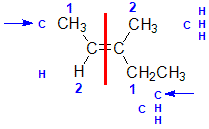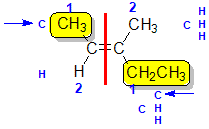 |
Basic IUPAC Organic Nomenclature
|
 |
Basic IUPAC Organic Nomenclature
|

As we have already seen, there are two ways to name these types of isomers: (for a review details follow the links)
The E- and Z- style is more reliable (i.e. potentially less ambiguous) and particularly suited to highly substituted
alkenes, especially when the substituents are not alkyl groups.
The E- and Z-alkene nomenclature system is based on the Cahn-Ingold-Prelog priority rules. They can also be used for naming chirality center stereoisomers (see later).
In order to apply the Cahn-Ingold-Prelog priority rules to alkenes:
Subrules:
Example: but-2-ene
 |
 |
 |
 |
|
| Step 1: Split the alkene |
Step 2: List the attached atoms looking for the first point of difference. Here we have C and H atoms attached. |
Step 3: |
Step 4: Look at the relative positions of the higher priority groups: same side = Z, hence (Z)-but-2-ene |
|
 |
 |
 |
 |
|
| Step 1: Split the alkene | Step 2: List the attached atoms looking for the first point of difference. Here we have C and H atoms attached. |
Step 3: Assign the relative priorities. Since the atomic numbers C > H then the -CH3 group is higher priority. |
Step 4: Look at the relative positions of the higher priority groups: opposite side = E, hence (E)-but-2-ene |
|
Example: 3-methylpent-2-ene
 |
 |
 |
 |
|
| Step 1: Split the alkene |
Step 2: Assign the relative priorities. The two atoms attached to the left end C are C and H, so since the atomic numbers C > H then the -CH3 group is higher priority. |
Step 3: |
Step 4: Look at the relative positions of the higher priority groups : opposite side = E, hence (E)-3-methylpent-2-ene. |
| ©Dr. Ian Hunt, Department of Chemistry |